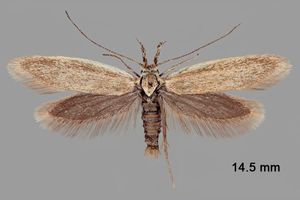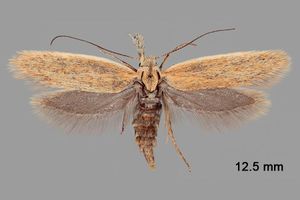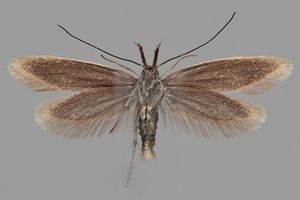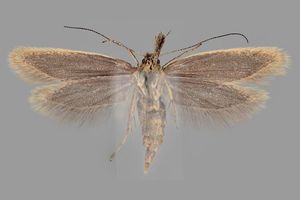

 +1Kontinente:EU
+1Kontinente:EU2. Diagnose
2.1. Männchen
2.2. Weibchen
4. Weitere Informationen
4.1. Etymologie (Namenserklärung)
Tabell et al. (2025: 54) erklären: "The specific name refers to the collecting area."
4.2. Taxonomie
Tabell et al. (2025) diskutieren die bisher 7 aus Spanien (inkl. Balearen und Kanaren) bekannten Pleurota-Arten und ergänzen sie um gleich 6 neu beschriebene Arten. P. pyrenaella sieht nach ihnen aus wie eine kleine, etwas zu bleiche P. hebetella oder P. amaurodoxa, mit denen sie genetisch auch tatsächlich nahe verwandt ist. Die Autoren erklären zur Genetik von P. pyrenaella: "Molecular data: Seven specimens of P. pyrenaella were sequenced, resulting in 658 bp (n=6) and 654 bp (n=1) barcodes. The nearest neighbour to P. pyrenaella is P. amaurodoxa, with a 3.49 % divergence. The barcodes of P. pyrenaella exhibit 0.15 % intraspecific variation."
4.3. Faunistik
Tabell et al. (2025: 54) schreiben knapp: "Known only from northern Spain." Ihr Typenmaterial stammt ausschließlich aus Aragón, Huesca, aus 740 bzw. 800 m Höhe in den spanischen Pyrenäen.
4.4. Typenmaterial
Tabell et al. (2025: 53) erklären: "Holotype ♂ (GP 5710 J. Tabell, DNA sample 25823 Lepid Phyl): SPAIN, Aragón, Huesca, 5.5 km SW Sabiñánigo, 740 m, N42.47143 W0.38573, 8-VII-2016, J. Tabell leg. (coll. MZH), BOLD sample ID: MM25823, http://id.luomus.fi/GBT.25 Paratypes: 23 ♂ (GP 5713 J. Tabell; GP 5869 J. Tabell, DNA sample 25825 Lepid Phyl; GP 5870J. Tabell, DNA sample 25592 Lepid Phyl; DNA sample 25593 Lepid Phyl; GP 5872 J. Tabell), 2 ♀ (DNA sample 25590 Lepid Phyl, DNA sample 25591 Lepid Phyl), same collecting data as holotype; 1 ♂, same collecting data, but 6-VII-2019; 6 ♂ (DNA sample 26330 Lepid Phyl), Spain, Aragón, Huesca, 2 km N Jaca, 800 m, 42.59453 -0.54540, 6-VII-2019, J. Tabell leg. (all coll. TAB, 2 exx. Coll. MNCN)."
(Autor: Erwin Rennwald)
4.5. Literatur
- Erstbeschreibung: Tabell, J., Honey, M., Leger, T., Mutanen, M., Nupponen, T. & P. Sihvonen (2025): New and poorly known Pleurota Hübner, [1825] species from peninsular Spain, the Balearic Islands, and the Canary Islands (Lepidoptera: Oecophoridae, Pleurotinae). — SHILAP Revista de lepidopterología, 53 (209): 43-74. [zum PDF-Download auf shilap.org]







